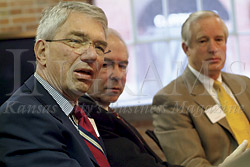
Mike Fishman discusses the viability of a grocery store in downtown KC. Tom Turner and Olen Monsees look on.
Fishman’s comments led to a spirited discussion on whether Downtown Kansas City needed the amenities you would find in a New York or Chicago. Murray thought otherwise. “Even though you live in the urban core,” she said of central Kansas City, “you still get in your car and drive.”
Block affirmed that people with easy access to cars don’t like to walk, especially in bad weather. “I’m not sure that this whole idea of a downtown grocery is as necessary as this city seems to think.”
Fishman disagreed. He cited a poll by one of the downtown agencies. It showed that the one item that most people wanted was a downtown grocery store. “The poll indicated that people were just clamoring for retail services,” Fishman said, “and that was the biggest reason why people find downtown living to be inconvenient.”
Steve Block countered that there is not yet sufficient population density. “I guarantee when they reach the critical mass,” he added, “Associated Wholesale Grocer, or somebody, will be down here with a store because they’ll want to get in here and squeeze out everybody else.”
Tom Turner argued that economic action will create new action Downtown. “We just have to stay the course,” he proposed.
The question was asked of Larry Buck with Prudential Summers, Realtors in St. Joseph whether the experience of that city suggests the difficulty of sustaining a viable downtown culture in a car-friendly city despite a city’s good intentions. Buck thought otherwise. He spoke in detail of the signs of life that are sparking downtown St. Joseph, including loft development, restored office space, performing arts and a revived entertainment district. Retail, however, remains a real problem. Still, he added, “There’s really a lot going on that you don’t see just walking around. You kind of have to know what deals are involved.”
Office
Shifting work patterns, including the trend by more and more workers to office at home, have left some observers wondering whether the office market will ever fully rebound.
For all the obstacles, Murray remains largely optimistic. What she sees as the most daunting challenge is the marketing of what she calls the “Behemoths,” the large Downtown towers. Paying for parking drives up the square foot costs of these buildings beyond market norms. “Ownership has been very aggressive,” she noted. “They are looking at markets outside of Kansas City to attract people to those zones.”
Despite concerns among colleagues, Greg Bates of MC Lioness Realty is bullish on Sprint continuing to operate out of its Overland Park campus.
Johnson County, as Field commented, has seen a “tiny, bit-by-bit” increase in occupancy over the last four quarters. “As long as it’s positive,” she added, “that’s a good thing.” Still, if one does the math, there is, as Field pointed out, a supply of office space in various markets of about three and a half to four years.
“I think there’s a little bit more underlying demand than maybe those numbers would show,” said Bucky Brooks, who admitted to being more optimistic than most.
“I think the market’s coming back,” Pat Beckner agreed. “We’re seeing activity in our buildings; we’re getting a lot of calls.”
Carl LaSala reported seeing an increase in those business owners who are inclined to say, “Why do I want to go lease space in an office building when I can go buy a piece of ground and build my own building and I have equity in it?”
LaSala believes that this trend results from a plentiful supply of money and low interest rates. Rather than the stock market, these entrepreneurs would much rather put their money in real estate, “where they can not only see it but feel it, touch it, smell it and have more control over what they do.” He thinks that this is one of the reasons why there has been a slow buildup of vacant office space.